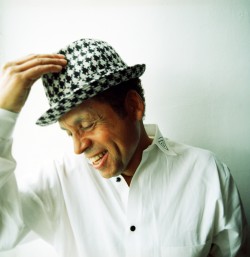Garland Jeffreys Reflects on Brooklyn’s “Power and Resonance”
Garland Jeffreys’ music has always been a blend of genres, which he says is “both a blessing and a curse because people don’t always know how to categorize me.” Having been raised in Sheepshead Bay, however, he simply couldn’t help absorbing so many musical styles.
“I grew up listening to the music of my parents, which was jazz, bebop, and the big band music of the day. My mother had me when she was 17, so she was still plugged into…singers like Sarah Vaughn and Billie Holiday,” he tells Brooklyn Roads. Jeffreys’ father was a big fan of Louis Armstrong; his uncle, who lived in the same house, “was a big jazz guy, kind of a hipster [and] my grandfather sat in the chair in the living room and watched The Kate Smith Hour.”
As Jeffreys grew a little older he began to hear what the “bigger guys” were listening to and started to discover more pop and soul. The guys on his corner – East 15th and Avenue Y, to be specific – were copying the doo-wop sounds of the day. “I was getting influenced by my parents, my peers, my uncle and the street corner for starters, he tells Brooklyn Roads.
Brooklyn itself was also influential in nurturing the budding young singer. “[There] was an unusual mixture of races and cultures in Sheepshead Bay at the time…black, Jewish, Italian, Caribbean…and that certainly affected my music. There were white guys at Lincoln High who were pretty hip too, he says. “That gave me the undergirding and the authenticity to allow me to explore a lot of different genres of music in my albums over the years.”
When he became a teenager, Jeffreys discovered The Teenagers, and it was their lead singer, Frankie Lymon, who proved to the biggest influence on him and his music.
“In my day…anyone who heard him wanted to be him.” When Jeffreys saw that guys like Lymon, who “was my age and he was not too tall” and even his friend Davy, who “sang like Smokey Robinson” could be great vocalists, that made it seem possible for him. So he began to emulate the guys on the street. “They were cool…and they got the girls!” he says.
The rest, as they say, is musical history, and a career that has garnered Jeffreys international acclaim. It may come as no surprise that wherever his tours have taken him – the UK, Europe and even Australia – the locals are always curious and interested to hear about New York City and Brooklyn in particular. “The myth of it all,” he says, has “so much power and resonance for them.”
Jeffreys believes he know why this is so and why his home borough has spawned so many talented songwriters and performers. “It’s the hippest place on the planet. Everybody mingles in a place like Brooklyn. It’s not an isolated lifestyle – people are not locked in their houses or cars, they’re out on the street, in the parks, on the beach, on the stoop and you literally hear all different styles music as you walk around, even today.”
One local young artist who has caught Jeffreys’ ear is Sophie Auster, who he says could be a “cool” partner for a duet. “Our voices might blend well.” But it’s another young woman with whom he is most eager to collaborate — his daughter, singer Savannah Jeffreys. “We may be doing something on my upcoming album” , he admits.He also has his eye on playing at Williamsburg’s The Hall at MP, which he says, “might be in the cards for this year.”
If and when he does, expect to hear a heavy dose of music from his most recent album, Truth Serum, which continues Jeffreys’ knack for blending genres- in this case rock, roots and reggae. He tells Brooklyn Roads that the songs on Truth Serum “came out as a reflection of what I was thinking about at the time, though some of these ideas are always with me. ‘All Around the World’ came out of my feelings about the economic circumstances of the times (which haven’t improved) – ‘bankers on the brink of disaster / jumping out of windows / they’re moving much faster / used to be a universe master / and now they lost everything’ – and ‘Coney Island Winter’ was about the plight of the people there.” It was, he says, directly inspired by a winter walk through the neighborhood and seeing the desolation, culminating in lyrics such as: “All the rides are broken down / say they’re gonna fix this town / straight from city hall.”
Truth Serum was crowd sourced, in part because, “I also wanted to get my fans around the world involved…as opposed to a more traditional album release. I’ll definitely do it again with PledgeMusic. They are really together.” Jeffreys adds, “The days of major label support are over. I never really trusted the record companies in the first place and recent developments have confirmed that.”
In keeping with his Brooklyn roots, Jeffreys is still backed up on stage by the Coney Island Playboys, although, he says, “we rarely use that name any more. It’s Mark Bosch on guitar, Brian Stanley on bass, Tom Curiano on drums and Charly Roth on keys. “We always joke that Brian has been with me longer than my wife, and it’s true.”
It’s also true that at age 72, Garland Jeffreys is still producing powerful music that resonates in Brooklyn and around the globe.



